
The Vulnerable Youth and Women Support Project is funded by the African Development Bank (AfDB) with counterpart funding from the Government of The Gambia. The project is aimed at responding to some of the most pressing priorities for both the Bank and the country, including youth employment, skills development, gender equality, and access to quality health infrastructures. The main development challenge the project will address is the low level of human development in the country, in particular high poverty rates, low access to basic social services, and high youth and women unemployment and underemployment rates.
The project has three (3) components:-
(i) to ccreate jobs and livelihood opportunities for vulnerable women and out-of-school youth in rural areas and increase their productivity and hence their incomes through skills development, non-financial support;
(ii) (ii) to improve their use and access to better and inclusive basic social services (education, health and nutrition, social protection), and
(iii) (iii) to reduce gender inequalities, by providing better economic and social prospects for young girls and women and reducing social expectations of male youth as household providers.
Rural areas will be the focus of the project considering the fact that 93.8 percent of households living in these areas are vulnerable. Three Local Government Areas (LGA) namely, Janjanbureh, Kuntaur and Basse, which collectively constitute one-third of the most vulnerable population in the country, have been chosen for the project implementation.
The main beneficiaries of the economic empowerment component are vulnerable youth and women, with special emphasis on the female out-of-school youth and returning migrants. As for women, the targeting criteria will be defined to ensure that those in vulnerable situations are prioritised by the project. Particular attention will be placed on widows, women heading households, women with disabilities, etc. Youth and women living with HIV&AIDS will also be considered.
The main beneficiaries of the component on access to basic social services is the entire populations in the project intervention LGAs LGAs (children, youth, women, and men). The component will include rehabilitation and re-equipping of health centres and gender transformative social behavioural change activities. Kuntaur, Janjanbureh and Basse LGAs have the worst health indicators in the country. For example, under-5 mortality ranges from 55 deaths per 1,000 live births in Basse to 79 deaths per 1,000 live births in Kuntaur. Stunting is highest in Kuntaur (25%), 21% in Basse and 19% in Janjanbureh.
Consequently, two among four recommended health centres, Kuntau and Fatato, will benefit from the project funded rehabilitation work. The chosen health facilities have the highest catchment area (42,670 inhabitants in the case of Fatoto and 34,560 in the case of Kuntaur). These health centres provide health services to a combine total of 129 communities (87 in Kuntaur and 42 in Fatoto).
In line with national regulatory requirements and AfDB Environment and Social Safeguards Policy requirements, the planned project interventions have been subjected to an environmental and social impact assessment culminating in the production of site-specific ESMP reports, which have been subjected to review and validation by the national EIA Technical Working Group.
Furthermore, in furtherance of requirements in the Environmental Impact Assessment Regulations 2014, the validated ESIA reports are being disclosed to allow the general public access the reports and provide their inputs, if any.
The reports will remain available for public review for a period of one month effective 8th July, 2023 to 8th August, 2023. ~ NEA FB
ESIA REPORT
